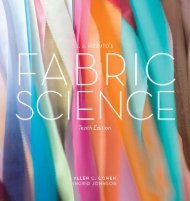Visual Merchandising Display - Fairchild Books
Visual Merchandising Display - Fairchild Books
Visual Merchandising Display - Fairchild Books
Create successful ePaper yourself
Turn your PDF publications into a flip-book with our unique Google optimized e-Paper software.
store’s light, the window light seems stronger. If a shopper<br />
passing by sees the light in the window, he or she will also<br />
see the display of merchandise and be aware of the retail<br />
space viewed to either side of the partial background. The<br />
shopper knows that the store is open; the shopper knows<br />
what kind of merchandise is available. If the retailer is<br />
enlightened enough, he or she will also add some interesting<br />
or exciting props—or furniture—to the display,<br />
enhancing the image of the merchandise and the store.<br />
Lighting the Closed-Back Window<br />
If the store has an enclosed display window—three walls, a<br />
floor, and a ceiling—the display person has greater opportunities<br />
for magical lighting effects. Not only can the display<br />
person highlight the featured merchandise and bring to it<br />
the attention it warrants, but he or she can also use light<br />
to “paint” the background a complementary or accenting<br />
color or dramatize the setting by creating a particular ambience;<br />
for example, blue and green lighting to simulate an<br />
underwater look or yellows and oranges mixed with reds<br />
to create the atmosphere of a setting sun or a rich day in<br />
autumn. Colored lights, colored filters, and theatrical gels<br />
all work wonderfully well to achieve these effects.<br />
Many theatrical lighting supply stores also carry a variety<br />
of cut-out, patterned light filters that create images in light<br />
on walls, floors, and even on the merchandise. With these<br />
pierced filters, one can have rain, snow, lightening, or sunshine;<br />
light streaming through a Gothic window for a bridal<br />
setting; palm trees in the tropics for swimwear; a starlit night<br />
for ball gowns; or fireworks for a red, white, and blue promotion—or<br />
a spectacular sale event. More expensive but<br />
also more effective are the filters that rotate around the light,<br />
causing movement and animation in the window.<br />
Using these techniques requires great control over the<br />
daylight that might, at certain times of the day, overpower<br />
the window lighting and the special effects. Awnings drawn<br />
down during the sunlight hours can help somewhat, but<br />
even better is setting the merchandise and the mannequins<br />
as far back as possible in the closed-back window to take<br />
full advantage of the lighting effects and to overcome the<br />
effects of glare and reflection. (See Figure 4.2.)<br />
34<br />
P a r t 1 : G e t t i n G S ta r t e d — V i S u a l M e r c h a n d i S i n G a n d d i S P l ay B a S i c S<br />
Figure 4.2 With an enclosed window, the display person has more<br />
opportunities for effective and theatrical lighting. As shown here, the<br />
focusable spots are located on a track above the windows, and the<br />
lamps can be targeted at the mannequins. Because the windows<br />
are fairly deep, there is opportunity for backlighting and the use of<br />
illuminated objects. Lord & Taylor, Fifth Avenue, New York.<br />
Incandescent lighting and MR16s, to be discussed later<br />
in this chapter, are the most effective sources for window<br />
display lighting.<br />
Planning Store Interior Lighting<br />
Now that we know the store is open, let us step inside and<br />
see what is to be seen. Light means seeing. Light serves to<br />
lead the shopper into and through the store. It directs the<br />
shopper’s attention from one featured presentation or classification<br />
to another, with stops along the way to appreciate<br />
the highlighted focal points and displays. It can separate<br />
one area from the next; one boutique or vendor’s shop













